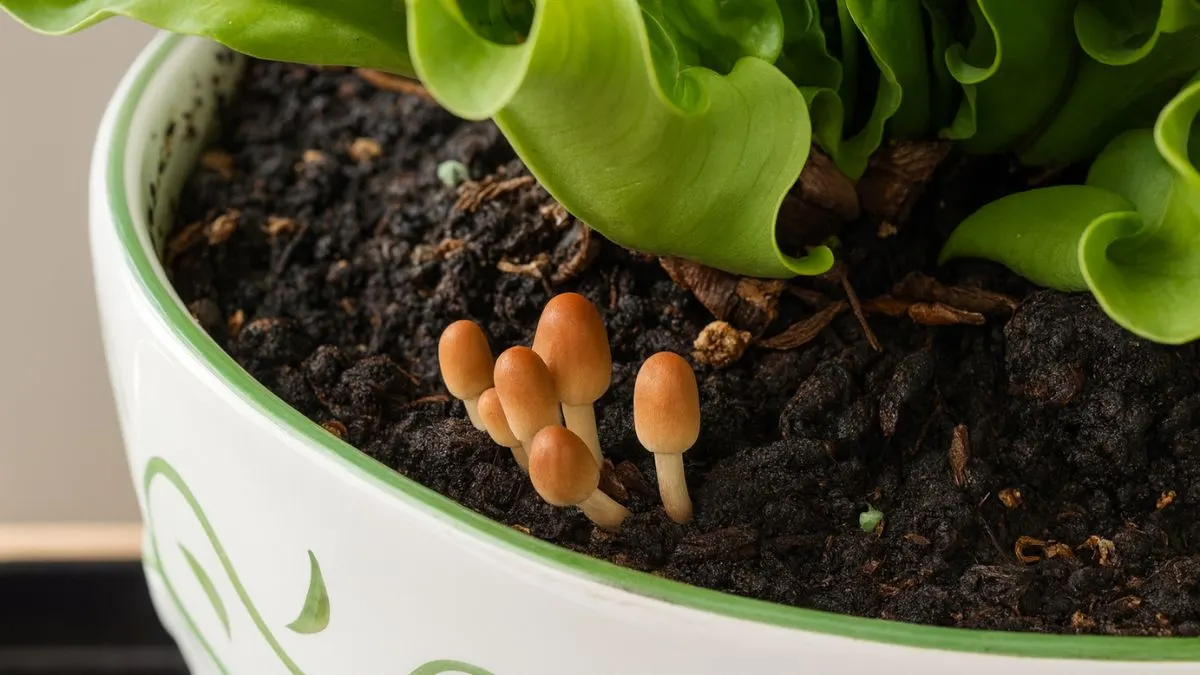Mushrooms sprouting from your indoor pots with forest fungi can be disconcerting, even maddening. Though they generally aren’t destroying your plants, their presence does indicate there is too much moisture and decaying organic matter in the soil. It can then spread spores and wreak havoc on the harmony of your houseplant ecosystem if you just let it get out of hand.
Why Are Mushrooms Growing in My Houseplants?

Mushrooms inhabit sites that are cool and damp, with access to organic matter. If indoor soil is too wet, or doesn’t contain enough airflow, the fungi spores start their germination and the mushrooms pop up inevitably.
It’s a battle plant lovers from Canada, the USA and beyond are fighting — especially in humid homes.
Some key causes:
- Overwatering and poor drainage
- Excess decomposed organic matter
- Lack of light and airflow
- Warm, moist conditions indoors
Also Read: How to Plant Mushrooms Indoors
Step-by-Step Methods to Remove Mushrooms
1. Physical Removal of Mushrooms
- Remove the mushrooms and at least 1–2 inches of soil.
- Cover with new sterilized potting mix.
- Discard into the trash (not compost).
2. Changing the Soil Completely
- Replace with a sterile potting mix.
- Reduces organic food available to the fungus.
3. Natural Antifungal Remedies
- Add cinnamon powder or neem oil on topsoil.
- Cinnamon is an all-natural antifungal agent.
- Spray water + neem oil for protection.
4. Improve Light and Airflow
- Fungi hate bright, ventilated environments.
- Move plants near windows or use fans.
Also Read: How to Grow and Care for the Syngonium Pink Plant at Home
5. Fungicidal Drench
- For severe infestations, use a fungicide drench.
- Must be safe for houseplants.
6. Rubbing Alcohol Spray
- Mix 1 cup alcohol + 4 cups water.
- Mist lightly on soil surface.
- Kills spores and prevents regrowth.
7. Pruning and Maintenance
- Mushrooms feed on decomposing leaves.
- Regularly prune plants and remove debris.
Options for Getting Rid of Mushrooms Fast
Approach |
Efficacy |
Safety |
Workload |
Hand removal + soil scrape |
High |
Very Safe |
Low |
Replace soil completely |
Very High |
Safe |
Medium |
Cinnamon on soil |
Medium–High |
Safe |
Low |
Neem oil / fungicide spray |
Moderate |
Safe (some) |
Medium |
Fungicidal drench |
High |
Needs caution |
Very High |
Alcohol spray |
Moderate |
Safe diluted |
Medium |
Enhance light & airflow |
Moderate |
Very Safe |
Low |
Plants Vulnerable to Mushrooms in Soil
- Indoor Prayer Plant – Needs moist soil, prone to fungus.
- Lupin Flowers – Need drainage to prevent mushrooms.
- Guduchi Plant – Benefits from neem oil in infested soil.
- Hawthorn Plants – Adapt well, less fungi with good care.
- Redbud Trees – Wet pots encourage mushrooms, fix with airflow & light.
- Celery – Excess moisture causes mushrooms.
- Amaranth – Grows in poor soils, mushrooms show too much organic matter.
Also Read: Morel Mushrooms: The Gourmet Treasure You Can Grow in Your Backyard
Personal Experience
Early in my gardening career, I panicked when I spotted mushrooms on my gardenia pot. At first, I thought they were harmless but the soil stayed too wet and the plant struggled. I repotted with sterile soil and sprinkled cinnamon powder. The gardenia recovered and bloomed with many flowers.
Lesson: Simple natural remedies can heal plants quickly.
Conclusion
Houseplant mushrooms are common but a sign to act. The best long-term fix:
- Remove mushrooms + top soil
- Replace with sterile mix
- Treat with cinnamon or neem oil
- Improve light and airflow
- Use fungicidal drenches only if severe
With these steps, you can keep your plants healthy and mushroom-free.
Whether you’re growing houseplants, ornamental flowers, or vegetables in Canada, USA, or anywhere, these tips will protect your green friends.






